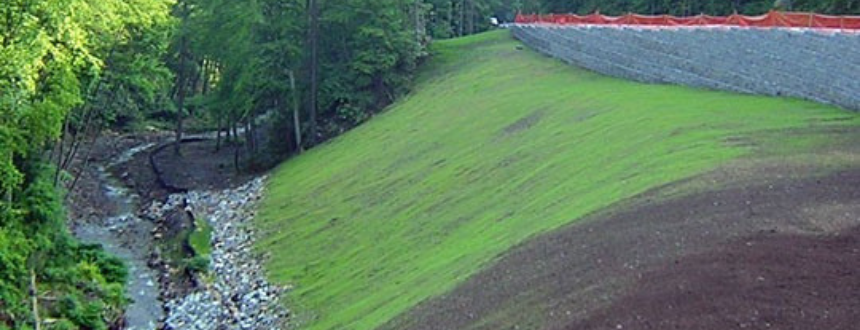
Seeded Compost Erosion Control Blanket, photo courtesy of Filtrexx
A compost blanket is a layer of compost applied on the soil surface as a mulch, typically at a depth of 2 inches or 270 cubic yards per acre. A compost blanket protects soil surfaces from wind and water erosion, conserves water, and moderates soil temperature. In addition, a compost blanket improves the soil’s physical, chemical, and biological properties, which provides a healthy growth medium, including nutrients, required for sustainable plant establishment.
Where to Use Compost Blankets
Use compost blankets where:
- Construction or other land disturbing activities are completed
- Soil is compacted and/or where soil organic matter (SOM) and nutrients are low and permanent vegetation is required
- Treatment of stormwater runoff is required
- Reduction of runoff volume is needed to allow reduction in size of stormwater collection, bioretention ponds, and rain gardens
Suggestions to Maximize Performance
- Apply a depth of 2 inches or 270 cubic yards per acre. An engineer may recommend application of a thicker blanket for additional reduction of runoff volume during large storm events.
- Install irrigation to ensure vegetation establishment.
- Install stormwater runoff diversion devices to prevent erosion and washing away of seed prior to vegetation establishment.
- Use additional stabilizers or support practices such as netting on slopes greater than 2:1.
- Compost should meet product quality specifications, such as those developed by Caltrans or Filtrexx.
- Compost blanket should meet performance and design specifications appropriate for site conditions and goals.
For guidance on determining a minimum compost application rate to provide nitrogen required for plant growth, see the Caltrans Application Rate Guidance section of its Incorporate Materials webpage.
Benefits of Compost Blankets
- Reduces erosion
- Provides plant nutrients in a stable, organic form
- Reduces stormwater runoff and velocity
- Increases water holding capacity
- Increases infiltration rate
- Conserves water
- Improves soil biology
- Provides plants with a healthy growth medium

Limitations
- High winds may blow compost away. If sites are located in areas of high wind, Caltrans recommends considering tacking compost blankets in place with Hydromulch or covering with RECP Netting (Type A). At these types of sites, use “Medium” or “Coarse” compost to minimize loss due to wind.
- Sites subject to heavy rain may require additional erosion control treatments to keep the compost in place. See Caltrans Erosion Control Toolbox and Filtrexx Design Manual for additional guidance on additional treatments to layer on the surface of compost blankets to hold compost in place.
Design Considerations
- Determine if new slopes will require incorporation of organics to support sustainable vegetation.
- Specify “Medium” or “Coarse” compost materials for compost blanket work to minimize the loss of compost due to wind.
- Consider combining compost blanket with netting or hydromulch on steep slopes.
- Consider treating sites with compacted, sterile, or poorly draining soils by combining compost blanket with local topsoil or incorporation of compost into soil.
Caltrans provides additional guidance on the Caltrans Erosion Control Toolbox Webpage on Compost. Additionally, see the Compost Research & Education Foundation’s compost specification sheets for erosion control blankets and upgrading marginal soils.
Specifications
CalRecycle regulations require that compost produced by commercial scale composting operations and facilities meet maximum metal concentrations, physical contamination limits, and pathogen reduction standards. CalRecycle requirements are minimum standards and local jurisdictions or other specifiers may have requirements that are more restrictive. See Product Quality and Specifications for additional information.
Common Compost Application Rates
| Depth (inches) | Cubic Yards/Acre | Cubic Yards/ 1,000 sq. ft. |
|---|---|---|
| 0.5 | 67 | 1.5 |
| 1.0 | 134 | 3.0 |
| 2.0 | 269 | 6.0 |
| 3.0 | 402 | 9.0 |
Note: tonnage varies based on compost bulk density.
See Caltrans Erosion Control Toolbox for compost application methods for compost blankets and additional information.
Resources
- USEPA Stormwater Best Management Practice – Compost Blankets EPA Compost Blanket Stormwater BMP
- California Stormwater Quality Association (CASQA): Compost blanket (EC 14)
- Filtrexx Storm Water Blanket Filtrexx Compost Storm Water Blanket
Research
- Faucette, L.B. et al (2006). Vegetation and soil quality effects from hydroseed and compost blankets used for erosion control in construction activities. Journal of Soil and Water Conservation. 61(6):355-362.
- Faucette, L.B. et al (2007). Erosion control and storm water quality from straw with PAM, mulch, and compost blankets of varying particle sizes. Journal of Soil and Water Conservation. 62(6):404-413.
Resources
For more information contact: Organic Materials, organics@calrecycle.ca.gov

